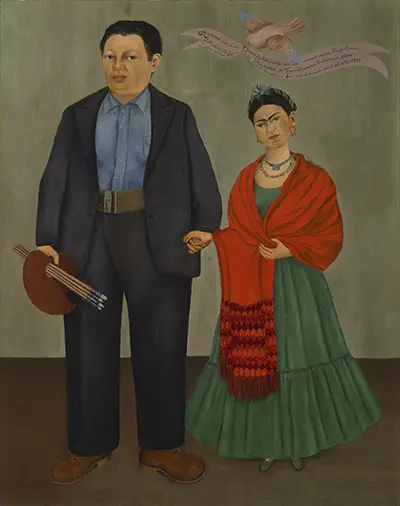Frida portrays herself as tiny and insubstantial beside her large and solidly planted husband brandishing a palette. This reflects not only the real physical disparity between them, but a self-portrayal as a wife in a great artist's shadow. Frida Kahlo (1907-1954) was a Mexican artist born in Coyoacan, outside Mexico City. With her father's encouragement, Frida grew into an able and ambitious student, attending the elite National Preparatory School with the intention of going on to study medicine. At this stage, Frida enjoyed art only as a hobby. She studied drawing with her father's friend, the print-maker Fernando Fernandez, to whom she became apprenticed as an engraver in 1925, doing this work alongside her studies.
In September 1925 Frida Kahlo suffered the terrible accident which altered the course of her life; her school bus collided with a streetcar. Suffering numerous broken bones and other injuries, Frida spent time in hospital and was confined to bed for months after. The lifelong impact on her health was such that Frida had to give up her ambition of becoming a doctor. As she convalesced at home, Frida began painting in earnest, mostly self-portraits and portraits of her sisters and friends. Her illness now made her consider art as a career as well as prompting an existential quest that was to inform her work. Her early paintings showed the influence both of Renaissance art and avant garde art movements such as Cubism.
By late 1927, Frida was able once again to socialise with her friends, who were now at university. She joined the Mexican Communist Party which gave her entree to a social circle of artists and activists. In 1928, Frida met 42 year old Diego Rivera, famous artist and prominent communist. He confirmed Frida's talent as an artist. The following year, the two of them were married. The couple moved to the city of Cuernavaca. Here, Frida began to be influenced by traditional Mexican culture both in her art and in her dress. Their turbulent relationship would then inspire much of Kahlo's work, such as The Broken Column, My Birth and Two Fridas. This was in addition to her own physical injuries and ensured a darker, sombre atmosphere to many of her self-portraits.
It is perhaps disturbing to witness the balance of power in their relationship within this painting. Their hands are held loosely, Frida understands that she is only one part of Diego's life and that he remains independant. Her relative size is also exaggerated in order to underline this imbalance in power. Her own artistic exploits and qualities are ignored in this composition, with the only artstic references being applied to her new husband. Considering his later infidelity, this painting almost predicts the future. Perhaps Kahlo's subconscious expected his later behaviour to occur, but could not admit this reality to herself at the time of her wedding.
This exceptional piece ranks as one of the most significant elements in the collection of the San Francisco Museum of Modern Art, but there is also plenty more to enjoy from other notable artists. Their own website features prominently this very painting alongside work by Georgia O'Keeffe, another female icon within the art world. Much of the rest of their main body of work is from the 21st century, including photography and sculpture. There are also paintings by Piet Mondrian, Robert Rauschenberg and Richard Diebenkorn. Kahlo's inclusion alongside these more recent artists underlines her ability to remain relevant even all these years later. Perhaps the most famous painting of all in their collection is The Flower Carrier by Diego Rivera, which offers another connection to the painting that we have discussed here. Frieda and Diego Rivera was donated to the collection as far back as 1937, courtesy of Albert M Bender, who contributed a number of pieces to the institution.

